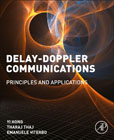
Delay-Doppler Communications: Principles and Applications
Hong, Mingyi
Thaj, Tharaj
Viterbo, Emanuele
Orthogonal Frequency Division Multiplexing (OFDM) has been the waveform of choice for most wireless communications systems in the past 25 years. This book addresses the what comes next?? question by presenting the recently proposed waveform known as Orthogonal Time-Frequency-Space (OTFS), which offers a better alternative for high-mobility environments. The OTFS waveform is based on the idea that the mobile wireless channels can be effectively modelled in the delay-Doppler domain. This domain provides a sparse representation closely resembling the physical geometry of the wireless channel. The key physical parameters such as relative velocity and distance of the reflectors with respect to the receiver can be considered roughly invariant in the duration of a frame up to a few milliseconds. This enables the information symbols encoded in the delay-Doppler domain to experience a flat fading channel even when they are affected by multiple Doppler shifts present in high-mobility environments. Delay-Doppler Communications: Principles and Applications covers the fundamental concepts and the underlying principles of delay-Doppler communications. Readers familiar with OFDM will be able to quickly understand the key differences in delay-Doppler domain waveforms that can overcome some of the challenges of high-mobility communications. For the broader readership with a basic knowledge of wireless communications principles, the book provides sufficient background to be self-contained. The book provides a general overview of future research directions and discusses a range of applications of delay-Doppler domain signal processing. With this book, the reader will be able to: Recognize the challenges of high-mobility channels affected by both multipath and multiple Doppler shifts in physical layer waveform design and performance; Understand the limitations of current multicarrier techniques such as OFDM in high-mobility channels; Recognize the mathematical and physical relations between the different domains for representing channels and waveforms: time-frequency, time-delay, delay-Doppler; Understand the operation of the key blocks of a delay-Doppler modulator and demodulator both analytically and by hands-on MATLAB examples; Master the special features and advantages of OTFS with regard to detection, channel estimation, MIMO, and multiuser MIMO; Realize the importance of delay-Doppler communications for current and future applications, e.g., 6G and beyond. This is the first book on delay-Doppler communications. It is written by three of the leading authorities in the field. It includes a wide range of applications. INDICE: 1. Introduction2. High-mobility wireless channels3. OFDM review and its limitations4. Delay-Doppler modulation5. Zak transform analysis for delay-Doppler communications6. Detection methods7. Channel estimation methods8. MIMO and multiuser OTFS9. Conclusions and future directionsAppendixA: Notation and acronymsB: Some useful matrix propertiesC: Some MATLAB code and examplesPlease visit the book's companion site for additional materials (MATLAB package code):https://www.elsevier.com/books-and-journals/book-companion/9780323850285(copy and paste the URL to your browser and search or reach it through the hyperlink available in the Resources box).
- ISBN: 978-0-323-85028-5
- Editorial: Academic Press
- Encuadernacion: Rústica
- Páginas: 260
- Fecha Publicación: 09/03/2022
- Nº Volúmenes: 1
- Idioma: Inglés
